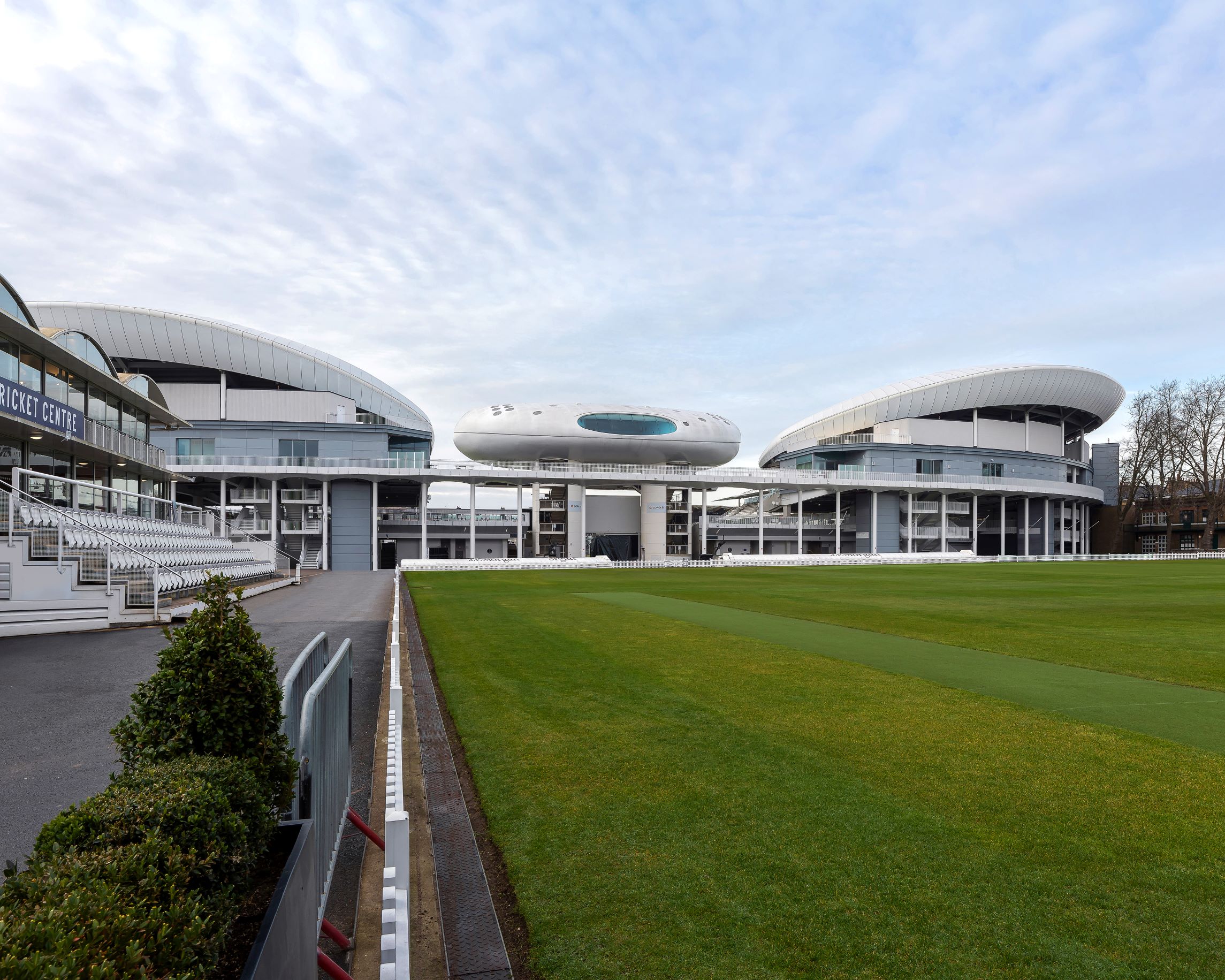Alumimium clad stands at Lords Cricket Ground
[edit] Cladding Balls Over Lords Cricket Ground Case Study
The existing stands on the ground's Nursery (eastern) End had become inadequate due to the needs of modern spectators, with restricted sightlines in the lower tiers and upper tiers entirely exposed to the elements. A decision was therefore taken to replace them with two new build stands, named after the famous cricketers Dennis Compton and John Edrich.
WilkinsonEyre architects were commissioned by the Marylebone Cricket Club (MCC) for the £53m redevelopment of the new stands, which flank either side of the Stirling Prize-winning Media Centre and Proteus Facades supplied striking aluminium cladding to the new Compton and Edrich stands.
The curved, elliptical form of WilkinsonEyre’s design makes the stands appear like ‘objects landed from outer space’, while providing a range of additional seating and hospitality areas (increasing the previous capacity from 9,000 to 11,600 seats), new concourses and circulation areas overlooking the Nursery Ground, public realm and landscaping allow the spectators to enjoy the facilities.
Proteus HR Solid and Perforated cladding panels in PPC aluminium with a RAL 7040 finish were specified for the corporate facilities at the rear of Compton and Edrich. A number of these panels had to be curved to accommodate the radius of the hospitality spaces.
The wall build-up on these elements comprises an SFS frame with cement board and insulation. A Proteus railing system comprising bespoke helping hand brackets and the company’s 50x50mm mullion grid allow the panels to be installed in a landscape pattern, giving the hospitality boxes on level one some horizontal definition in contrast to the vertical feel of the primary roof cladding.
Around the first floor soffit, Proteus SC Perforated panels were introduced in 3mm aluminium with a RAL 9003 finish. These were installed at an angle to generate a zone for the various M&E routes that were required between the two stands. They extend at an angle from the service access up to the projecting first tier level. These angled soffits are again on a curve that follows the overall stand design. This required a number of elliptical and shaped panels manufactured to specific locations on the detailed plan.
The positioning of the panels and structural connection points meant there was a relatively large drop from the concrete slab to accommodate M&E services. A combination of L and U aluminium extrusion sections and brackets developed a standard framework to which Proteus’s 125mm x 50mm mullions could connect. The spanning capacity of the 125mm x 50mm section allowed a reduced framing structure which improved the access zones for the M&E installation trades.
This considered approach to the structure and panels allowed for a simplistic installation through an agreed sequence, allowing the manufacturing process to keep the sites teams busy during the condensed installation periods created by the Covid pandemic.
Blending harmoniously with the previously constructed Media Centre, the aluminium clad, elliptically shaped, 24 metre high designs soften the bold media box and blend the new with the historical aspect of this great amphitheatre for cricket.
[edit] External links
[edit] Related articles on Designing Buildings
Featured articles and news
CIOB report; a blueprint for SDGs and the built environment
Pairing the Sustainable Development Goals with projects.
Latest Build UK Building Safety Regime explainer published
Key elements in one short, now updated document.
UKGBC launch the UK Climate Resilience Roadmap
First guidance of its kind on direct climate impacts for the built environment and how it can adapt.
CLC Health, Safety and Wellbeing Strategy 2025
Launched by the Minister for Industry to look at fatalities on site, improving mental health and other issues.
One of the most impressive Victorian architects. Book review.
Common Assessment Standard now with building safety
New CAS update now includes mandatory building safety questions.
RTPI leader to become new CIOB Chief Executive Officer
Dr Victoria Hills MRTPI, FICE to take over after Caroline Gumble’s departure.
Social and affordable housing, a long term plan for delivery
The “Delivering a Decade of Renewal for Social and Affordable Housing” strategy sets out future path.
A change to adoptive architecture
Effects of global weather warming on architectural detailing, material choice and human interaction.
The proposed publicly owned and backed subsidiary of Homes England, to facilitate new homes.
How big is the problem and what can we do to mitigate the effects?
Overheating guidance and tools for building designers
A number of cool guides to help with the heat.
The UK's Modern Industrial Strategy: A 10 year plan
Previous consultation criticism, current key elements and general support with some persisting reservations.
Building Safety Regulator reforms
New roles, new staff and a new fast track service pave the way for a single construction regulator.
Architectural Technologist CPDs and Communications
CIAT CPD… and how you can do it!
Cooling centres and cool spaces
Managing extreme heat in cities by directing the public to places for heat stress relief and water sources.
Winter gardens: A brief history and warm variations
Extending the season with glass in different forms and terms.
Restoring Great Yarmouth's Winter Gardens
Transforming one of the least sustainable constructions imaginable.


























